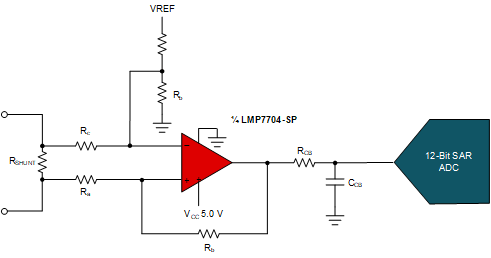JAJU808 July 2021
- 概要
- リソース
- 特長
- アプリケーション
- 5
- 1System Description
-
2System Overview
- 2.1 Block Diagram
- 2.2
Design Considerations
- 2.2.1 System Control and Processing
- 2.2.2 Analog Front End
- 2.2.3 Input Voltage Monitoring: 5 V, 20 V, 40 V, and ±5 V
- 2.2.4 Bidirectional Current Sense: ±2 A
- 2.2.5 Unipolar Current Sense: 0.25 A to 1 A
- 2.2.6 TMP461-SP: Local and Remote Temperature Sensing
- 2.2.7 NTC Thermistor Temperature Sensing
- 2.2.8 Adjustable Voltage Source
- 2.2.9 Fixed Output Current Source
- 2.2.10 Adjustable 4-mA Current Source
- 2.2.11 Power Tree and Power Sequencing
- 2.3 Highlighted Products
- 3Hardware, Software, Testing Requirements, and Test Results
- 4Design and Documentation Support
- 5About the Author
2.2.4 Bidirectional Current Sense: ±2 A
The current sense circuit is used to measure a current range over ±2 A at an accuracy range of 1%, similar to current requirements typically seen in the thermoelectric cooler. The bidirectional circuit configuration shown in Figure 2-4 converts an input current source into an output voltage. The circuit can be used on either the high side or low side of a circuit. If low-side sensing, then there are no Vcm limitations, but should not be used in applications where the system load cannot withstand small ground disturbances or in applications that need to detect load shorts. High-side sensing requires a high CMRR to reject any changes in Vbus and should not be used when common mode might exceed amplifier supply (Vcm = Vbus). For more information, see the Analog Engineer's Circuit: Low-side bidirectional current sensing circuit.
 Figure 2-4 Bidirectional Current Sense
Circuit
Figure 2-4 Bidirectional Current Sense
Circuit